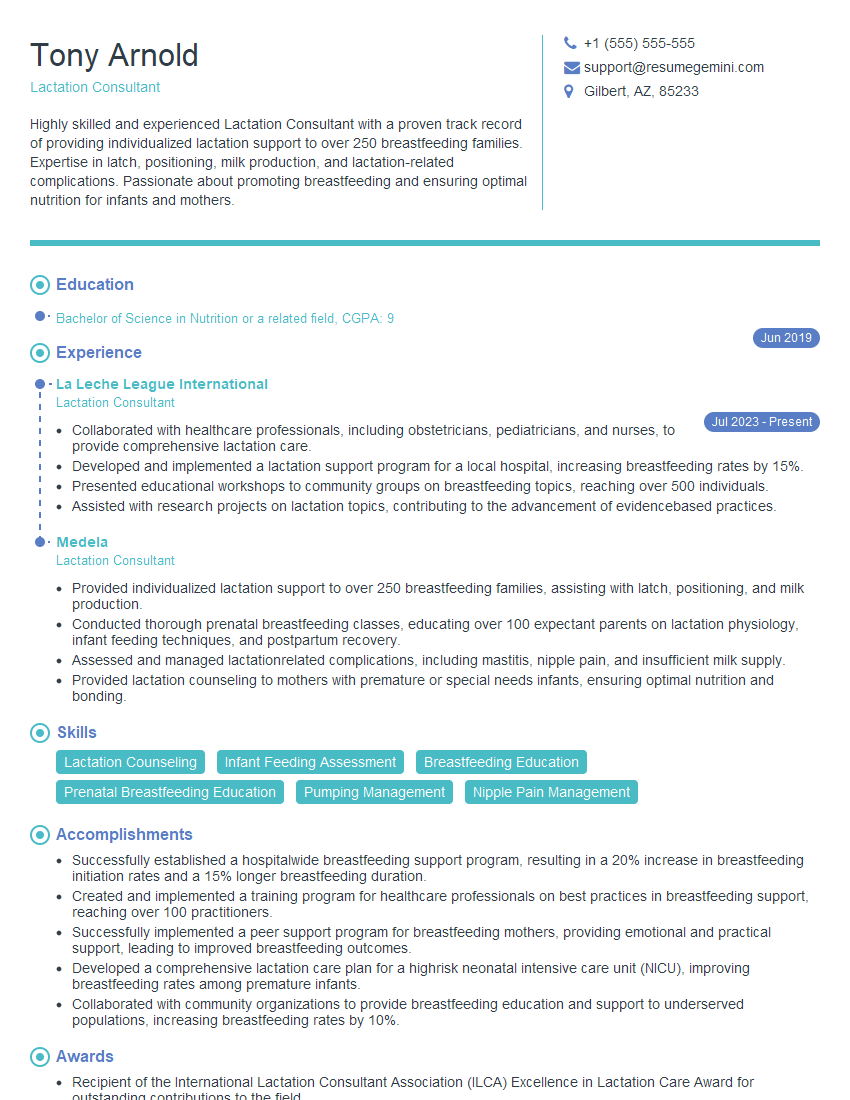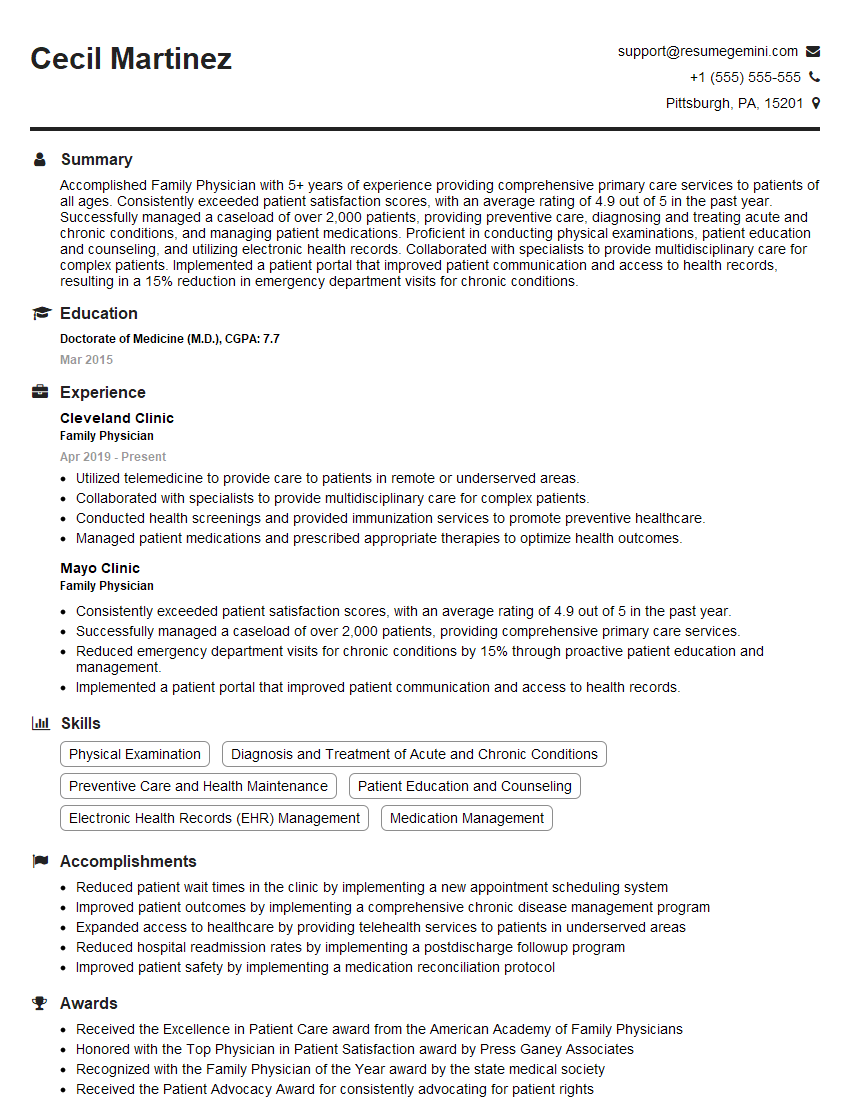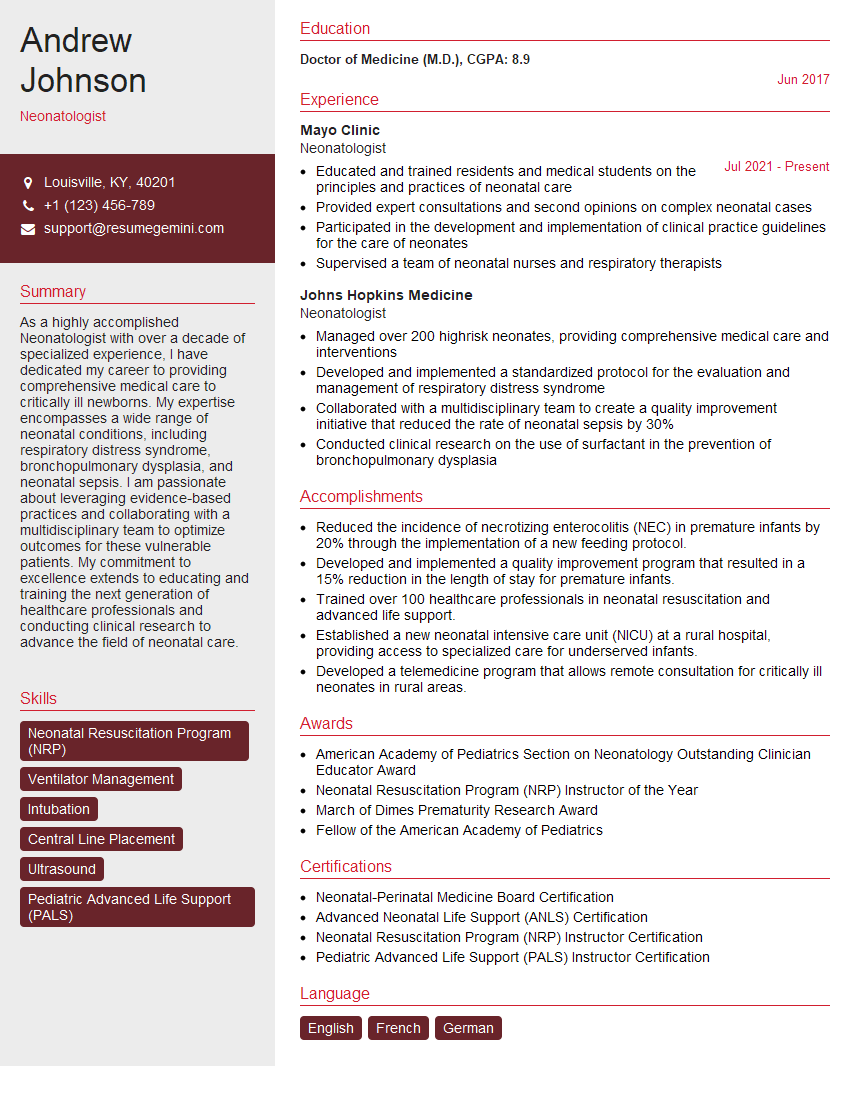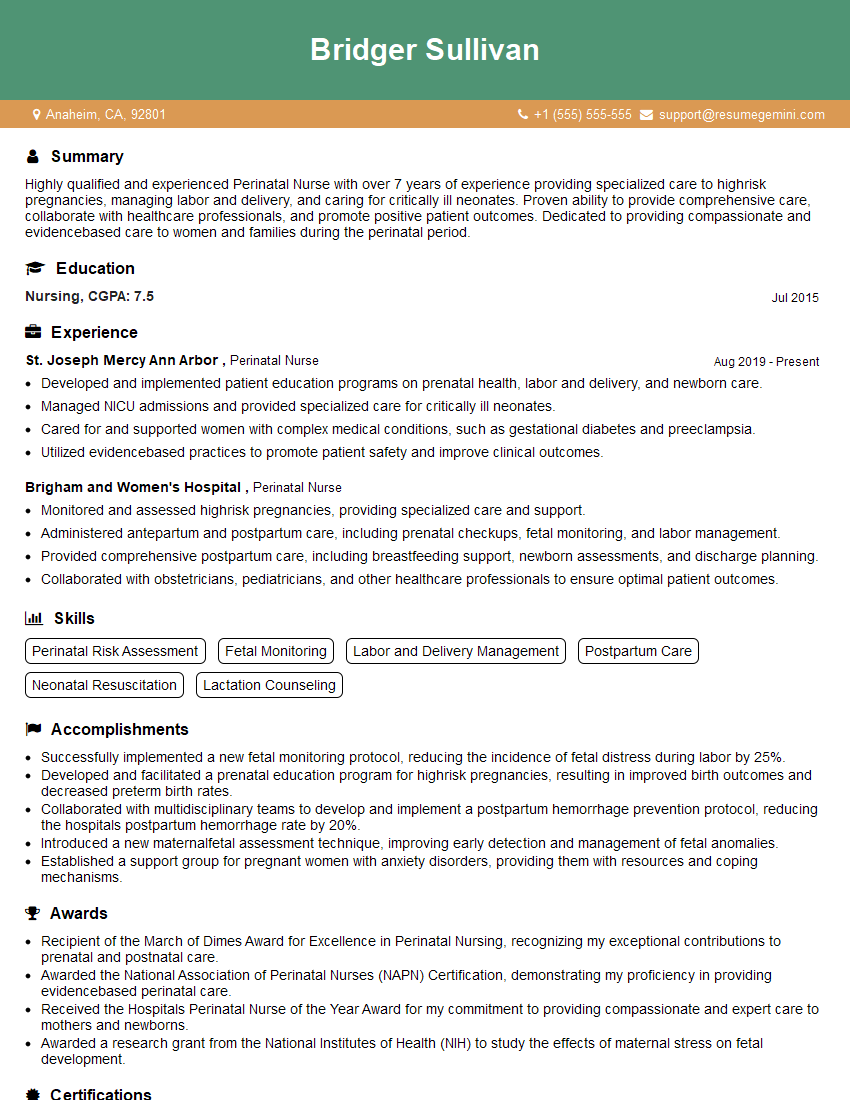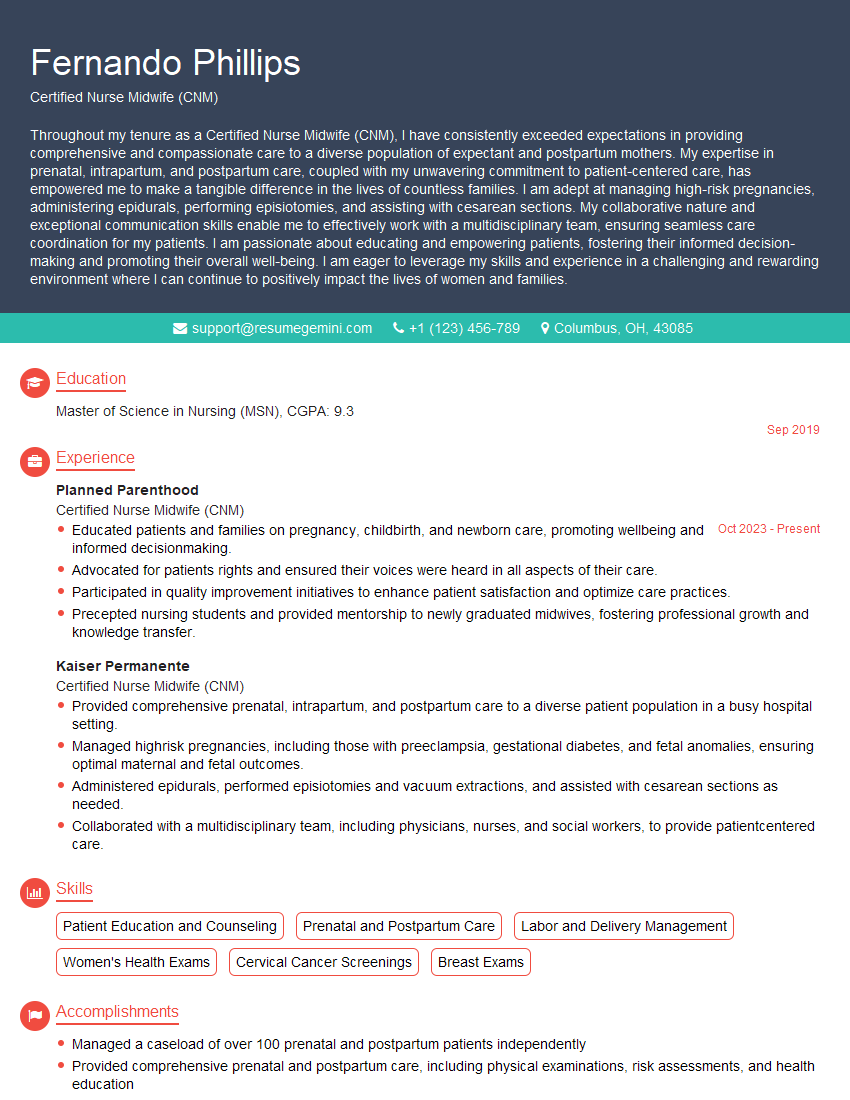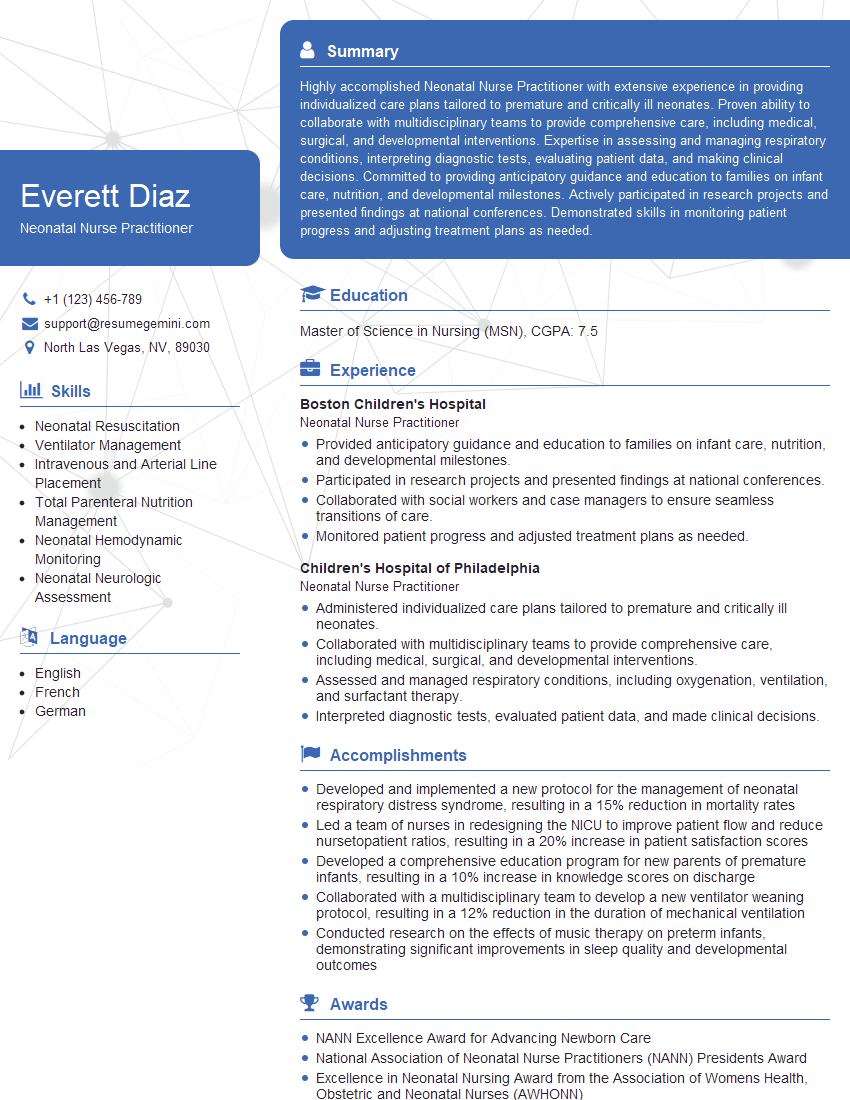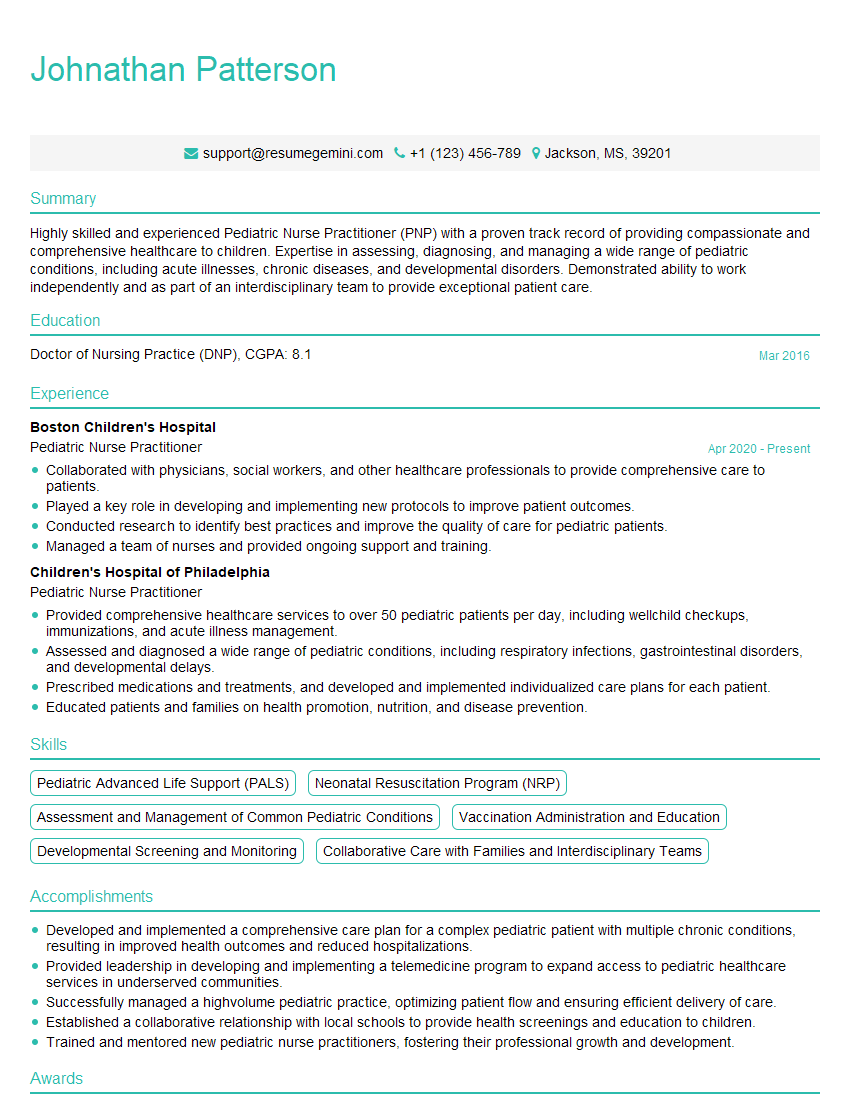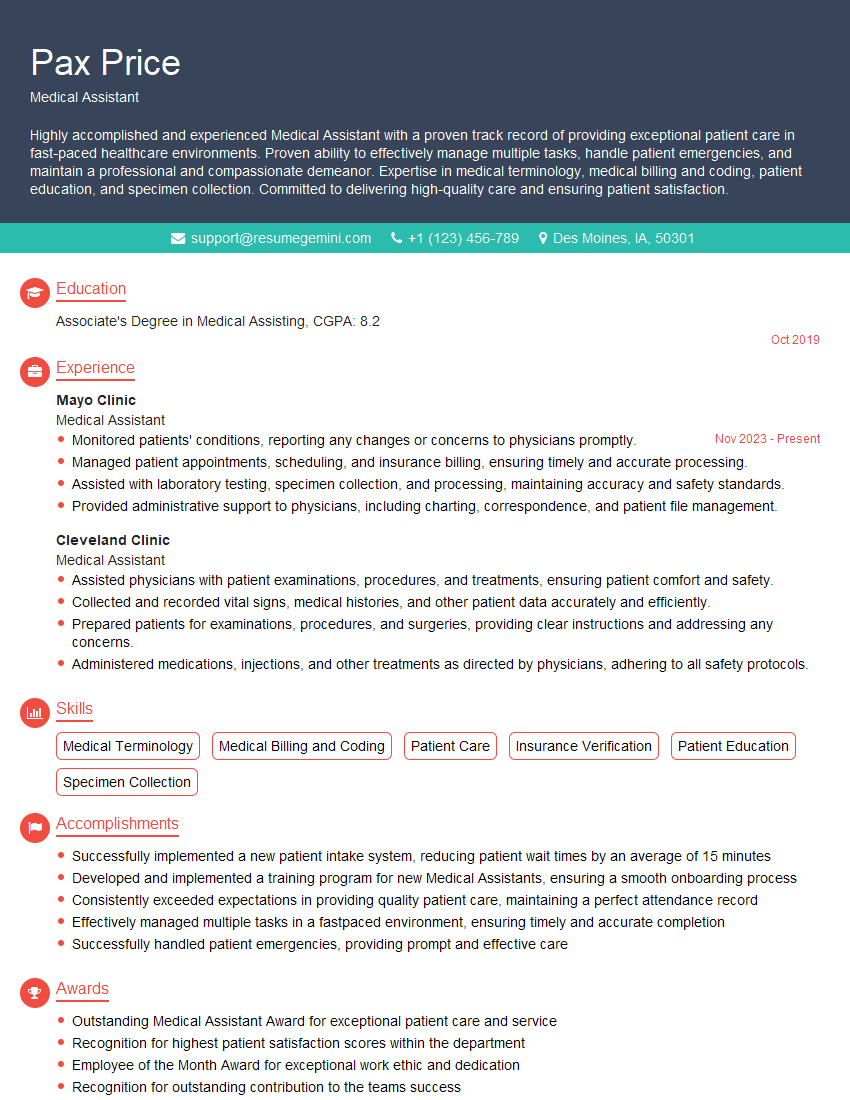Unlock your full potential by mastering the most common Preterm Labor Management interview questions. This blog offers a deep dive into the critical topics, ensuring you’re not only prepared to answer but to excel. With these insights, you’ll approach your interview with clarity and confidence.
Questions Asked in Preterm Labor Management Interview
Q 1. Define preterm labor and its associated risks.
Preterm labor is defined as regular uterine contractions resulting in cervical change (effacement and/or dilation) before 37 weeks of gestation. This is a significant obstetrical concern because it carries substantial risks for both the mother and the baby.
- For the baby: Premature infants may experience respiratory distress syndrome (RDS) due to underdeveloped lungs, intraventricular hemorrhage (bleeding in the brain), necrotizing enterocolitis (NEC, a serious bowel condition), retinopathy of prematurity (ROP, eye damage), and cerebral palsy. Long-term developmental delays, learning disabilities, and vision or hearing impairment are also possibilities.
- For the mother: Risks include postpartum hemorrhage, infection (chorioamnionitis), and future preterm births. The emotional stress associated with preterm labor and its potential consequences significantly impacts maternal well-being.
Imagine a scenario where a mother goes into labor at 28 weeks – the baby’s lungs are far from mature, leading to a high risk of serious complications. This highlights the critical need for effective preterm labor management.
Q 2. Describe the diagnostic criteria for preterm labor.
Diagnosing preterm labor requires a combination of clinical findings and assessments. There isn’t one single test; rather, a clinical picture is built.
- Regular uterine contractions: This is typically defined as four or more contractions in an hour. It’s crucial to differentiate between true labor contractions (regular, increasing in intensity and frequency) and Braxton Hicks contractions (irregular, painless).
- Cervical change: Progressive effacement (thinning) and dilation (opening) of the cervix are key indicators. A digital cervical exam is usually performed to assess this.
- Gestational age: The pregnancy must be less than 37 weeks gestation.
It’s important to note that some women may experience symptoms like backache, pelvic pressure, or vaginal discharge without actually being in preterm labor. A thorough evaluation is crucial to differentiate between these symptoms and true preterm labor.
Q 3. Explain the role of cervical length assessment in preterm labor prediction.
Cervical length assessment, often performed by transvaginal ultrasound, plays a significant role in predicting preterm labor. A shorter cervical length is associated with an increased risk of preterm delivery.
A cervical length of less than 25 mm in the second trimester is often considered a strong predictor of preterm birth. However, it’s important to note that a short cervix doesn’t guarantee preterm labor, and not all women with short cervixes will deliver prematurely. Other factors, such as the presence of infections or previous preterm births, also need to be considered. Think of cervical length as one piece of the puzzle in assessing risk, not the sole determinant.
Regular cervical length monitoring in high-risk pregnancies can aid in tailoring interventions and providing timely management, potentially preventing premature birth in some cases.
Q 4. Outline the management strategies for suspected preterm labor.
Management of suspected preterm labor depends on several factors, including gestational age, the presence of infections, fetal well-being, and maternal health. The overall goal is to prolong the pregnancy as long as possible to allow for fetal lung maturity.
- Assessment and monitoring: This involves a comprehensive evaluation of maternal and fetal health, including vital signs, fetal heart rate monitoring, and cervical examination.
- Hospitalization: Often required for close monitoring and initiation of preventative measures.
- Infection treatment: If an infection is suspected (e.g., chorioamnionitis), appropriate antibiotics are administered.
- Tocolysis (suppression of uterine contractions): Medications may be used to temporarily reduce contractions, providing time for interventions (see next answer).
- Corticosteroid administration: To enhance fetal lung maturity (see next answer).
- Lifestyle modifications: Rest, hydration, and avoidance of strenuous activity are recommended.
For example, a pregnant woman presenting with regular contractions and a shortened cervix at 30 weeks may be hospitalized, given tocolytics to suppress contractions, and receive corticosteroids to improve fetal lung maturity.
Q 5. Discuss the use of tocolytics in preterm labor management.
Tocolytics are medications used to suppress uterine contractions in preterm labor. Their use is controversial, as evidence of their long-term benefits is mixed. The primary goal is to buy time to allow for the administration of corticosteroids and to improve fetal lung maturity.
- Magnesium sulfate: A commonly used tocolytic, it’s also neuroprotective for the fetus. It can cause side effects like nausea, weakness, and decreased reflexes.
- Beta-mimetics (e.g., terbutaline): These drugs stimulate beta-adrenergic receptors, relaxing uterine muscles. They can cause maternal side effects like tachycardia and palpitations.
- Calcium channel blockers (e.g., nifedipine): These drugs relax uterine muscles by blocking calcium channels. Side effects can include hypotension and headache.
Tocolytics are generally not used beyond a few days because the evidence regarding their long-term efficacy is limited. Furthermore, delaying delivery might expose the fetus to other potential risks. The decision to use tocolytics should be made carefully, considering the potential risks and benefits for both mother and baby.
Q 6. Describe the indications for corticosteroid administration in preterm labor.
Corticosteroids (such as betamethasone or dexamethasone) are crucial in preterm labor management. They accelerate fetal lung maturation by stimulating the production of surfactant, a substance essential for proper lung function. Administering corticosteroids reduces the risk of respiratory distress syndrome (RDS) in premature infants.
The ideal time to give corticosteroids is between 24 and 34 weeks of gestation. The benefit diminishes significantly after 34 weeks. A single course is usually sufficient, and repeat administration is generally not recommended unless there is a significant time gap between the initial course and delivery.
Consider a scenario where a woman is admitted for preterm labor at 28 weeks. Administering corticosteroids is a high priority to give the baby’s lungs the best chance of proper function after birth.
Q 7. Explain the importance of fetal fibronectin testing.
Fetal fibronectin (fFN) is a protein found in the fetal membranes. Testing for fFN in vaginal secretions can help to assess the risk of preterm delivery within the next two weeks. A negative fFN test strongly suggests that preterm labor is unlikely in the near future. However, a positive test doesn’t definitively predict preterm labor; it simply increases the probability.
fFN testing is usually performed for women between 22 and 34 weeks of gestation who are experiencing symptoms suggestive of preterm labor but have an indeterminate cervical examination. It’s a useful tool to help decide whether additional interventions, such as hospitalization or close monitoring, are necessary. It’s important to remember that fFN testing is only one component of the risk assessment and shouldn’t be used in isolation to make crucial decisions about management.
Q 8. What are the potential complications associated with preterm birth?
Preterm birth, defined as birth before 37 weeks of gestation, carries significant risks for both the infant and the mother. Complications can be broadly categorized into short-term and long-term effects.
- Short-term complications for the infant: Respiratory Distress Syndrome (RDS), due to underdeveloped lungs; Intraventricular hemorrhage (bleeding in the brain); Necrotizing enterocolitis (NEC), a serious bowel disease; Patent ductus arteriosus (PDA), a heart condition; hypothermia; and sepsis (infection).
- Long-term complications for the infant: Cerebral palsy; intellectual disability; visual and hearing impairments; chronic lung disease (bronchopulmonary dysplasia); learning disabilities; attention deficit hyperactivity disorder (ADHD); and autism spectrum disorders. These long-term effects can significantly impact the child’s development and quality of life.
- Complications for the mother: Postpartum hemorrhage; infection (chorioamnionitis, endometritis); anxiety and depression related to the preterm birth; and potential difficulties with breastfeeding.
The severity of complications depends on several factors, including the gestational age at birth, the infant’s birth weight, and the presence of other medical conditions.
Q 9. How do you assess fetal lung maturity?
Assessing fetal lung maturity is crucial in managing preterm labor, as it helps determine the risk of respiratory distress syndrome (RDS) in the newborn. The primary method is analyzing amniotic fluid for the presence of certain substances.
- Lecithin/Sphingomyelin (L/S) ratio: This is a widely used test. Lecithin and sphingomyelin are phospholipids found in fetal lung fluid. A ratio of 2:1 or greater generally indicates adequate lung maturity. A ratio below 2:1 suggests immaturity and increased risk of RDS.
- Phosphatidylglycerol (PG): The presence of PG in amniotic fluid is a strong indicator of lung maturity. Its absence suggests immaturity.
- Surfactant-albumin ratio: This test measures the amount of surfactant relative to albumin in the amniotic fluid. A high ratio indicates mature lungs.
These tests are typically performed using amniocentesis. The decision to perform these tests and the interpretation of the results are made in conjunction with the gestational age, clinical presentation, and other factors. It’s important to note that no single test is perfect, and clinical judgment is critical in making decisions about delivery.
Q 10. Discuss the role of magnesium sulfate in preterm labor.
Magnesium sulfate is a commonly used tocolytic agent (a drug that slows or stops uterine contractions) in the management of preterm labor. Its primary role is neuroprotective, meaning it helps protect the developing fetal brain from injury. While it can also help delay delivery, its neuroprotective effects are considered more significant.
Specifically, magnesium sulfate reduces the risk of cerebral palsy and other neurological problems in infants born prematurely. It acts by blocking calcium channels, thus reducing the excitability of neurons. The dosage and administration route are carefully determined based on the patient’s condition and gestational age. It’s important to note that while effective, magnesium sulfate is not a long-term solution for preterm labor. It buys time to allow for the administration of corticosteroids for fetal lung maturation and other supportive care measures before delivery.
Monitoring for side effects like hypotension, respiratory depression, and decreased deep tendon reflexes is essential during magnesium sulfate administration. Careful attention to fluid balance is also important.
Q 11. Describe the nursing care for a patient in preterm labor.
Nursing care for a patient in preterm labor focuses on several key areas: close monitoring, preventing infection, promoting maternal and fetal well-being, and providing emotional support.
- Continuous fetal monitoring: This is essential to assess the fetal heart rate and uterine activity. Changes in fetal heart rate patterns can indicate fetal distress.
- Vital signs monitoring: Regular monitoring of the mother’s blood pressure, pulse, respiration, and temperature is crucial to detect any signs of complications.
- Fluid balance management: Intravenous fluids may be administered to maintain hydration and improve uterine perfusion.
- Medication administration: This may include tocolytics (like magnesium sulfate), antibiotics (if infection is suspected), and corticosteroids (to promote fetal lung maturity).
- Infection prevention: Strict adherence to infection control protocols is paramount, including hand hygiene and sterile techniques.
- Emotional support: Preterm labor is a stressful experience for parents. Providing empathy, education, and support is crucial.
- Education and anticipatory guidance: Educating the patient and her family about the potential complications, treatment plan, and neonatal intensive care unit (NICU) stay helps them prepare for what to expect.
Nursing care involves close collaboration with the obstetric team, neonatologists, and other healthcare professionals to provide optimal care for both the mother and the baby.
Q 12. Explain the importance of infection control in preterm labor management.
Infection control is paramount in preterm labor management because infection can significantly worsen the prognosis for both the mother and the baby. Intra-amniotic infection (infection of the amniotic fluid) is a major cause of preterm labor and can lead to severe complications, such as chorioamnionitis (infection of the membranes surrounding the fetus) and sepsis in both the mother and the newborn.
Strict adherence to infection control protocols is crucial. This includes meticulous hand hygiene, proper use of sterile gloves and gowns during procedures, and adherence to aseptic techniques. Prompt administration of antibiotics is essential if infection is suspected. Preventing urinary tract infections (UTIs), a common source of ascending infection, through adequate hydration and timely treatment is equally important. Continuous monitoring for signs of infection is necessary, as early detection is key to preventing severe complications.
A multidisciplinary approach involving nurses, physicians, and other healthcare providers is essential to maintain a safe and sterile environment.
Q 13. How do you counsel patients about preterm labor risk factors?
Counseling patients about preterm labor risk factors involves a sensitive and informative discussion tailored to each individual’s circumstances. It is crucial to approach this conversation with empathy, allowing space for questions and concerns.
Risk factors should be discussed without causing undue alarm but with sufficient clarity. Common risk factors include:
- Prior preterm birth: Women who have previously delivered preterm babies are at significantly higher risk.
- Multiple gestation pregnancies: Twins, triplets, or higher-order multiples increase the risk.
- Short cervical length: A cervix that is shorter than normal during pregnancy indicates an increased risk of preterm delivery.
- Preeclampsia or hypertension: High blood pressure during pregnancy can contribute to preterm labor.
- Infection: Any infection during pregnancy, including urinary tract infections (UTIs), increases the risk.
- Bleeding during pregnancy: Vaginal bleeding can indicate placental problems and increase the risk.
- Certain medical conditions: Conditions such as diabetes, autoimmune disorders, and chronic kidney disease may increase risk.
- Lifestyle factors: Smoking, substance abuse, and inadequate prenatal care are also associated with increased risk.
Counseling should emphasize preventative measures such as regular prenatal care, healthy lifestyle choices, and prompt attention to any concerning symptoms. The goal is to empower the patient to take an active role in minimizing her risk.
Q 14. Discuss the ethical considerations surrounding preterm labor management.
Ethical considerations in preterm labor management are complex and multifaceted, often involving balancing the potential benefits and harms for both the mother and the infant. Key ethical considerations include:
- Shared decision-making: Involving the pregnant person in decisions about management, including the potential risks and benefits of interventions like tocolysis, corticosteroids, and delivery at different gestational ages, is paramount.
- Balancing maternal and fetal well-being: Decisions need to consider both the mother’s health and the infant’s well-being, often in scenarios where interventions may benefit one at the expense of the other. This is particularly crucial in cases of severe preeclampsia or other maternal conditions that necessitate early delivery.
- Resource allocation: The high cost and resource intensity of neonatal intensive care are ethical considerations, especially in resource-limited settings. Decisions need to be made about resource allocation equitably and transparently.
- Informed consent: Providing complete and understandable information about the potential risks and benefits of interventions, as well as alternative approaches, enables the patient to make informed choices.
- End-of-life decisions: In cases of extreme prematurity where survival is unlikely or where significant long-term disability is anticipated, difficult decisions about resuscitation and life support may need to be made in accordance with the patient’s wishes and values.
Ethical decision-making in preterm labor management requires a multidisciplinary approach involving obstetricians, neonatologists, nurses, ethicists, and the patient and her family, fostering open communication and collaboration.
Q 15. What are the key components of a preterm labor care plan?
A preterm labor care plan is a comprehensive strategy designed to prolong pregnancy and improve neonatal outcomes. It’s highly individualized, depending on the gestational age, the mother’s health, and the severity of the labor. Key components include:
- Accurate Assessment: This involves a thorough evaluation of the patient’s medical history, current symptoms (uterine contractions, backache, pelvic pressure), cervical examination (checking for dilation and effacement), and fetal assessment (fetal heart rate, fetal movement).
- Tocolysis (if indicated): This involves the use of medications to suppress uterine contractions. The choice of medication and the duration of treatment depend on various factors (see Question 3 for more details).
- Hydration: Intravenous fluids are typically administered to improve uterine blood flow and placental perfusion (see Question 4).
- Fetal Monitoring: Continuous electronic fetal monitoring is crucial to assess fetal well-being throughout the process (see Questions 2 and 5).
- Corticosteroids: Administering corticosteroids (e.g., betamethasone) helps accelerate fetal lung maturity, reducing the risk of respiratory distress syndrome in the newborn.
- Antibiotics: If there’s an infection suspected or confirmed, antibiotics are administered to prevent chorioamnionitis (infection of the amniotic fluid).
- Patient Education and Support: Educating the patient about the condition, the treatment plan, and potential complications is vital for her emotional well-being and cooperation (see Question 7).
- Delivery Planning: If tocolysis fails or if there are significant complications, a plan for delivery, including neonatal intensive care unit (NICU) transfer, needs to be established.
For instance, a patient presenting at 28 weeks gestation with regular contractions and cervical changes might receive tocolysis, corticosteroids, intravenous fluids, and close fetal monitoring. In contrast, a patient at 34 weeks with mild contractions and a stable cervix might receive only observation and education.
Career Expert Tips:
- Ace those interviews! Prepare effectively by reviewing the Top 50 Most Common Interview Questions on ResumeGemini.
- Navigate your job search with confidence! Explore a wide range of Career Tips on ResumeGemini. Learn about common challenges and recommendations to overcome them.
- Craft the perfect resume! Master the Art of Resume Writing with ResumeGemini’s guide. Showcase your unique qualifications and achievements effectively.
- Don’t miss out on holiday savings! Build your dream resume with ResumeGemini’s ATS optimized templates.
Q 16. How do you monitor fetal heart rate in preterm labor?
Fetal heart rate (FHR) monitoring is paramount in preterm labor. We typically use continuous electronic fetal monitoring (EFM) using external or internal methods.
- External Monitoring: Uses ultrasound transducers placed on the mother’s abdomen to detect FHR and uterine contractions. This is non-invasive but may not always provide the clearest signal.
- Internal Monitoring: Involves placing a small electrode on the fetal scalp (scalp electrode) and a pressure catheter into the uterine cavity. This is more accurate but is invasive and carries a slightly higher risk of infection.
The EFM tracing is continuously evaluated for patterns indicative of fetal distress such as decelerations, tachycardia, or bradycardia. Interpretation of these patterns guides management decisions, including the potential need for immediate delivery.
For example, persistent late decelerations (FHR slowing down after a contraction) might signal uteroplacental insufficiency, requiring immediate intervention. Conversely, a reassuring FHR tracing with baseline variability indicates a healthy fetus, allowing for a more cautious approach.
Q 17. Describe the different types of tocolytic medications and their side effects.
Tocolytic medications aim to relax the uterine muscles and reduce the frequency and intensity of contractions. Several medications are available, each with its own advantages, disadvantages, and potential side effects. Some common examples include:
- Magnesium Sulfate: A widely used tocolytic. It’s relatively safe, but side effects can include nausea, vomiting, flushing, headache, and even respiratory depression in high doses. We closely monitor the patient’s respiratory rate, deep tendon reflexes, and urine output when using magnesium sulfate.
- Beta-mimetics (e.g., Terbutaline): These stimulate beta-adrenergic receptors in the uterus, causing relaxation. Side effects can include tachycardia (increased heart rate) in both the mother and the fetus, palpitations, hypertension, and pulmonary edema.
- Calcium Channel Blockers (e.g., Nifedipine): These drugs block calcium channels, reducing muscle contraction. Side effects can include hypotension (low blood pressure), headache, flushing, and dizziness.
The choice of tocolytic depends on various factors, including the gestational age, the presence of contraindications, and the patient’s overall health. For example, a patient with severe cardiac disease might not be a candidate for beta-mimetics due to their potential to exacerbate cardiac issues.
Q 18. Explain the process of initiating and managing intravenous fluids in preterm labor.
Intravenous (IV) fluids are a cornerstone of preterm labor management. They are primarily used to maintain adequate hydration, improve uterine blood flow, and increase placental perfusion. This is especially important because dehydration can exacerbate uterine contractions.
The process involves:
- Establishing IV Access: A peripheral IV line is established to administer fluids.
- Fluid Selection: Isotonic solutions like Lactated Ringer’s or Normal Saline are commonly used.
- Fluid Rate: The rate of infusion is adjusted based on the patient’s clinical condition, including urine output and hydration status. A bolus of fluids might be given initially, followed by a maintenance infusion.
- Monitoring: Close monitoring of vital signs, urine output, and fluid balance is crucial to prevent fluid overload or dehydration.
For example, a patient with mild dehydration and preterm contractions might receive a bolus of 1000 mL of Lactated Ringer’s solution, followed by a maintenance infusion of 125 mL/hour. Regularly assessing her urine output helps us to adjust the infusion rate accordingly.
Q 19. How do you interpret fetal monitoring strips in the context of preterm labor?
Interpreting fetal monitoring strips in preterm labor requires expertise. We look for patterns that indicate fetal well-being or distress. A normal tracing shows a baseline heart rate between 110-160 bpm with moderate variability (fluctuations in the FHR).
Concerning patterns include:
- Tachycardia or Bradycardia: Persistently high or low heart rates can signal fetal distress.
- Decreased Variability: Reduced fluctuation in the FHR can indicate fetal hypoxia (lack of oxygen).
- Late Decelerations: These are FHR drops that occur after uterine contractions, suggesting uteroplacental insufficiency.
- Variable Decelerations: These are sudden drops in FHR, often associated with cord compression.
For example, recurrent late decelerations might necessitate immediate intervention, including repositioning the mother, administering oxygen, or even performing an emergency Cesarean section. In contrast, a reassuring tracing allows for continued observation and management of the preterm labor with less urgency.
Q 20. Discuss the role of bed rest in preterm labor management.
The role of bed rest in preterm labor management is debated. While it was once widely recommended, current evidence suggests that strict bed rest is not beneficial and may even have negative consequences. The focus has shifted to activity restriction rather than complete bed rest.
The concept of ‘modified bed rest’ involves reducing physical activity and avoiding strenuous activities. The goal is to reduce stress on the uterus and enhance blood flow to the placenta. However, complete immobilization can lead to complications like muscle atrophy, deep vein thrombosis, and psychological distress. Therefore, we encourage patients to engage in gentle activities like walking and rest periods, balancing activity with rest.
Q 21. Explain the importance of patient education in preterm labor.
Patient education in preterm labor is crucial for successful management and positive outcomes. It empowers women to actively participate in their care and promotes adherence to the treatment plan. Key aspects of patient education include:
- Understanding Preterm Labor: Explaining the causes, risk factors, and potential complications of preterm labor is essential.
- Treatment Plan Explanation: Clearly explaining the purpose and potential side effects of medications and procedures used.
- Recognizing Warning Signs: Educating patients to monitor for and report any changes in uterine contractions, bleeding, or fetal movement.
- Self-Care Strategies: Teaching patients about hydration, nutrition, and stress reduction techniques.
- Coping Mechanisms: Providing emotional support and resources to help patients cope with anxiety and stress.
- Follow-up Care: Instructing patients about post-discharge monitoring and follow-up appointments.
For instance, a patient who understands the importance of hydration and recognizes the early signs of preterm labor is more likely to seek medical attention promptly, significantly improving the chance of successful management.
Q 22. Describe the signs and symptoms of preterm labor.
Preterm labor is labor that begins before 37 weeks of pregnancy. Recognizing its signs and symptoms is crucial for timely intervention. Symptoms can vary significantly from woman to woman, but some common indicators include:
- Regular contractions: These are contractions that occur at regular intervals, becoming closer together and stronger over time. Think of them like menstrual cramps but more intense and rhythmic. A good rule of thumb is contractions every 10 minutes or less for an hour.
- Lower back pain: A persistent, dull ache in the lower back, often accompanied by contractions, can be a sign.
- Pelvic pressure: A feeling of increased pressure or heaviness in the pelvic area.
- Vaginal discharge: An increase in vaginal discharge, especially if it’s watery, bloody, or mucousy. This could indicate the rupture of membranes.
- Abdominal cramping: Cramping in the abdomen, often similar to menstrual cramps, but more persistent.
It’s important to note that not all women experience all of these symptoms, and some may only experience a few. Any woman experiencing concerning symptoms, especially those listed above, should contact her healthcare provider immediately.
Q 23. What are the long-term effects of preterm birth on the infant?
Preterm birth carries significant long-term risks for infants, affecting various aspects of their development. The severity depends on the gestational age at birth and the infant’s individual health status. Potential long-term effects include:
- Neurological problems: Cerebral palsy, intellectual disability, learning disabilities, and attention deficit hyperactivity disorder (ADHD) are all potential long-term risks, particularly in extremely premature infants.
- Respiratory issues: Premature infants often have underdeveloped lungs, leading to chronic respiratory problems like bronchopulmonary dysplasia (BPD).
- Vision and hearing impairments: Retinopathy of prematurity (ROP) and hearing loss can occur due to the immaturity of the eyes and ears.
- Gastrointestinal problems: Premature babies are more susceptible to gastrointestinal issues like necrotizing enterocolitis (NEC), a severe disease affecting the intestines.
- Developmental delays: Preterm infants may experience delays in motor skill development, language acquisition, and cognitive development.
- Increased risk of infections: Their immature immune systems make them more vulnerable to infections.
These effects can be mitigated through early intervention, specialized care in the NICU, and ongoing support throughout childhood. Regular developmental screenings are essential.
Q 24. Discuss the role of the neonatal intensive care unit (NICU) in managing preterm infants.
The Neonatal Intensive Care Unit (NICU) plays a vital role in managing preterm infants. It provides specialized care to address the unique challenges these babies face due to their prematurity. The NICU offers:
- Respiratory support: Ventilation (CPAP, mechanical ventilation) to help infants breathe.
- Temperature control: Maintaining a stable body temperature (thermoregulation) using incubators or radiant warmers.
- Nutritional support: Providing nutrition through intravenous lines (IV) or specialized feeding tubes (NG or OG tubes) until infants can feed orally.
- Infection control: Protecting infants from infections through strict hygiene practices and antibiotic treatment.
- Monitoring: Constant monitoring of vital signs, oxygen saturation, and other parameters.
- Medical interventions: Addressing complications like heart problems, brain bleeds, or retinopathy of prematurity.
- Developmental care: Providing stimulation and support to promote healthy development.
- Parental support: Providing emotional and educational support to parents during a stressful time.
The NICU team, including neonatologists, nurses, respiratory therapists, and other specialists, works collaboratively to provide comprehensive, individualized care.
Q 25. Describe the different types of neonatal respiratory support.
Neonatal respiratory support varies depending on the infant’s gestational age, lung maturity, and severity of respiratory distress. Methods include:
- Continuous Positive Airway Pressure (CPAP): Delivers a continuous flow of air pressure to keep the airways open and improve oxygenation. Think of it as gentle, constant pressure helping the lungs inflate.
- Mechanical Ventilation: A machine that breathes for the infant, delivering breaths at a set rate and pressure. This is used for severe respiratory distress.
- High-Frequency Oscillatory Ventilation (HFOV): Delivers rapid, small-volume breaths to improve oxygenation in critically ill infants.
- Surfactant Replacement Therapy: Administering surfactant, a substance that reduces surface tension in the lungs, improving lung expansion and reducing respiratory distress.
- Oxygen Therapy: Providing supplemental oxygen to improve oxygen levels in the blood.
The choice of respiratory support is made on a case-by-case basis, guided by the infant’s clinical condition and ongoing assessment.
Q 26. How do you manage complications such as chorioamnionitis in preterm labor?
Chorioamnionitis, an infection of the amniotic fluid, is a serious complication that can occur during preterm labor. Management involves:
- Antibiotics: Broad-spectrum antibiotics are administered intravenously (IV) to combat the infection. The specific antibiotic choice depends on the suspected pathogen.
- Close monitoring: The mother and the fetus are closely monitored for signs of worsening infection or fetal distress. This includes monitoring maternal vital signs, fetal heart rate, and uterine activity.
- Delivery: In many cases, especially if the infection is severe or the fetus shows signs of distress, delivery is the best option to protect both mother and baby. The decision to deliver is based on various factors, including the severity of infection, gestational age, and fetal well-being.
- Supportive care: Supportive care for the mother includes managing fever, fluid balance, and pain. For the infant, this includes providing respiratory support and other necessary interventions in the NICU.
Early recognition and prompt treatment are crucial to minimize the risk of adverse outcomes for both the mother and the baby. Prolonged infection can lead to serious complications, so rapid intervention is key.
Q 27. Explain the role of teamwork and communication in preterm labor management.
Effective teamwork and communication are absolutely essential in managing preterm labor. It requires a multidisciplinary approach, involving:
- Obstetricians: Lead the management of the pregnancy and delivery.
- Neonatal specialists: Provide care for the infant after birth.
- Nurses: Provide continuous monitoring and support to the mother and baby.
- Respiratory therapists: Manage respiratory support for the infant.
- Pharmacists: Ensure safe and effective medication administration.
Clear and consistent communication between all team members is paramount. Regular team meetings, detailed documentation, and open communication channels are crucial to ensure that everyone is on the same page and working towards the same goal – optimizing outcomes for both the mother and the infant. Effective handover communication between shifts and healthcare providers is vital in preventing errors and delays.
Q 28. Describe your experience with managing a high-risk pregnancy complicated by preterm labor.
I recall managing a patient at 28 weeks gestation who presented with regular contractions and a short cervix. She had a history of previous preterm birth and was considered high risk. The initial management involved hospital admission, bed rest, and administration of tocolytics (medications to stop contractions). We closely monitored her fetal heart rate and uterine activity. In this particular case, despite the tocolytics, her contractions persisted. We administered corticosteroids to promote fetal lung maturity. Following a careful assessment of the risks and benefits, and after a discussion with the patient and her family, we decided to proceed with delivery. The baby was born at 29 weeks, requiring immediate respiratory support and NICU care. Fortunately, with the intensive care provided, the baby eventually thrived and was discharged home without any major long-term complications. This case highlights the importance of individualized care, ongoing assessment, timely intervention, and effective communication with both the patient and her family in the management of high-risk pregnancies complicated by preterm labor.
Key Topics to Learn for Preterm Labor Management Interview
- Risk Factors for Preterm Labor: Understanding the various maternal, fetal, and environmental factors contributing to preterm birth. This includes recognizing both modifiable and non-modifiable risks.
- Diagnosis and Assessment: Mastering the methods used to diagnose preterm labor, including evaluating cervical changes, fetal fibronectin testing, and assessing uterine activity. This also involves understanding the limitations of each diagnostic tool.
- Management Strategies: Familiarize yourself with the different approaches to managing preterm labor, including tocolysis (medications to suppress contractions), cervical cerclage (surgical procedure), and antenatal corticosteroid administration. Understand the indications and contraindications for each.
- Patient Education and Counseling: Develop your ability to effectively communicate risk factors, treatment options, and potential outcomes to patients and their families. This requires strong interpersonal and communication skills.
- Monitoring Fetal Well-being: Gain a thorough understanding of techniques used to monitor fetal health during preterm labor, including fetal heart rate monitoring and biophysical profiles. Know how to interpret these assessments.
- Neonatal Outcomes and Implications: Understand the potential short-term and long-term consequences of preterm birth on the neonate, including respiratory distress syndrome, necrotizing enterocolitis, and developmental delays. This includes knowledge of appropriate neonatal interventions.
- Ethical Considerations: Be prepared to discuss ethical dilemmas that may arise in the management of preterm labor, such as balancing maternal and fetal well-being.
- Research and Evidence-Based Practice: Demonstrate familiarity with current research and evidence-based guidelines for the management of preterm labor. This shows your commitment to continuous learning and best practices.
Next Steps
Mastering Preterm Labor Management significantly enhances your value as a healthcare professional, opening doors to specialized roles and career advancement. A strong resume is crucial for showcasing your skills and experience to potential employers. Creating an ATS-friendly resume is vital for maximizing your job prospects. We highly recommend using ResumeGemini, a trusted resource, to build a professional and impactful resume. ResumeGemini offers examples of resumes specifically tailored to Preterm Labor Management roles, helping you present your qualifications effectively.
Explore more articles
Users Rating of Our Blogs
Share Your Experience
We value your feedback! Please rate our content and share your thoughts (optional).
What Readers Say About Our Blog
This was kind of a unique content I found around the specialized skills. Very helpful questions and good detailed answers.
Very Helpful blog, thank you Interviewgemini team.

